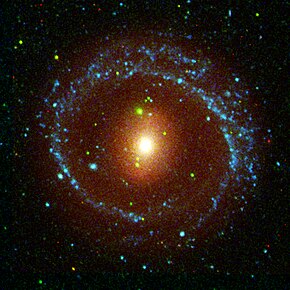NGC1291,also known asNGC 1269,[4]is aring galaxywith an unusual inner bar and outer ring structure located about 33 millionlight-yearsaway in theconstellationEridanus.[1]It was discovered byJames Dunlopin 1826 and subsequently entered into theNew General Catalogueas NGC 1291 byJohan Ludvig Emil Dreyer.John Herschelthen observed the same object in 1836 and entered it into the catalog as NGC 1269 without realizing that it was a duplicate.[4]This galaxy was cited as an example of a "transitional galaxy" byNASA'sGalaxy Evolution Explorerteam in 2007.[5]
| NGC1291 | |
|---|---|
 This composite image of NGC 1291 is processed primarily from data collected byNASA'sGalaxy Evolution Explorerin December 2003. The blue in this image isultravioletlight captured by GALEX's long wavelength detector, the green is ultraviolet light detected by its short wavelength detector, and the red in the image is visible light courtesy of data from theCerro Tololo Inter-American ObservatoryinChile.[1] | |
| Observation data (J2000epoch) | |
| Constellation | Eridanus |
| Right ascension | 03h15m29.6s[2] |
| Declination | −41° 17′ 25.6″[2] |
| Redshift | 0.002799 (839 ± 2 km/s)[2] |
| Distance | 33Mly |
| Apparent magnitude(V) | 9.39[2] |
| Absolute magnitude(V) | −21.05[3] |
| Characteristics | |
| Type | (R_1)SB(l)0/a[2] |
| Apparent size(V) | 9′.8 × 8′.1[2] |
| Notable features | inner bar and outer ring structure |
| Other designations | |
| PGC012209,[2] | |
Properties
editNGC 1291 faces towards the Solar System nearly face-on. It has a prominentbulge,and is forming stars in its disk, albeit slowly, being a lenticular galaxy.[3]
Like other early-type galaxies, NGC 1291 has a population of oldglobular clusters.About 65% of them belong to the "blue" population that is moremetal-poor,while the rest are "red" and more metal-rich.[3]
Gallery
edit-
HSTMosaic
-
UV vs Visible
References
edit- ^abDunbar, Brian (November 22, 2007). Watanabe, Susan (ed.)."NGC 1291".NASA.Archived fromthe originalon March 5, 2016.RetrievedApril 1,2012.
- ^abcdefg"NASA/IPAC Extragalactic Database".Results for NGC 1291.RetrievedOctober 30,2009.
- ^abcHixenbaugh, Kyle; Chandar, Rupali; Mok, Angus (2022)."The Ancient Globular Clusters of NGC 1291".The Astronomical Journal.163(6): 271.arXiv:2205.14047.Bibcode:2022AJ....163..271H.doi:10.3847/1538-3881/ac680d.S2CID248853311.
- ^ab"NGC 1291".Capella Observatory.2005.RetrievedApril 1,2012.
- ^Dunbar, Brian (November 22, 2007). Watanabe, Susan (ed.)."Portrait of a Galaxy's Life".NASA.Archived fromthe originalon April 6, 2012.RetrievedApril 1,2012.
External links
edit- "The Stellar Kinematics in NGC 1291: Constraints to Models of Bar Formation and Evolution"(PDF).
- Horton, Adam."Spitzer NGC 1291 barred spiral galaxy seen in infrared."23 October 2014.